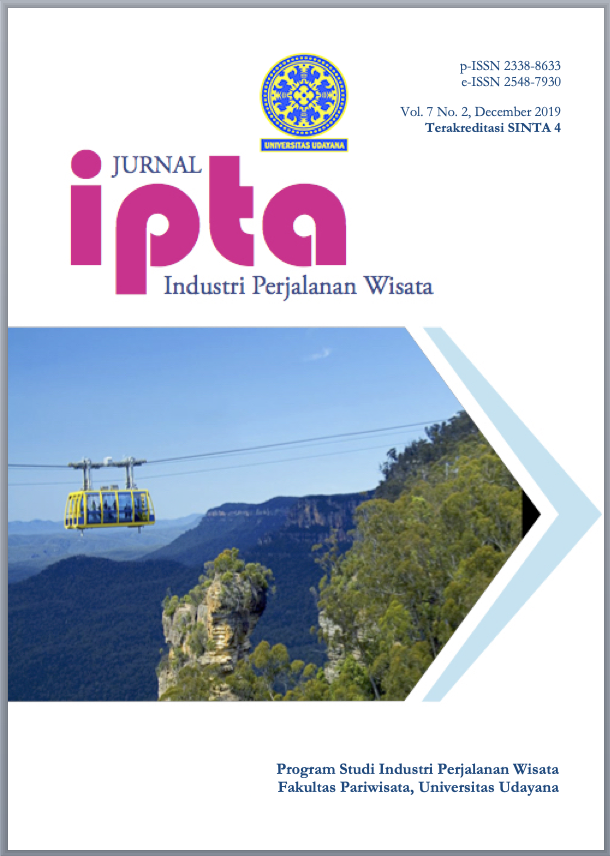IMPLEMENTASI ACCESSIBLE TOURISM DI TMII JAKARTA
Abstract
Indonesia is a big country consisting of various tribes and has different cultures from one to another. From this came the idea to create a tourist site with a cultural background. Taman Mini Indonesia Indah is a tourist attraction established since 1975, an attraction with the theme of Indonesian culture. Taman Mini Indonesia Indah is still a tourist destination that has been chosen by many families. Likewise, schools that still do a lot of tourist visits for study tours Visitors to Taman Mini Indonesia Indah are still the second most in Jakarta. With the development of tourism, the concept of tourism for all it becomes an absolute necessity. Because throughout the world there is also a very significant increase in the number of tourists, and ten percent have special needs including elderly people, tourists with small children, pregnant women, tourists with permanent and temporary disabilities. Therefore, the purpose of this study is to find out to what extent Taman Mini Indonesia Indah has implemented accessibility in tourism in accordance with standards set by the UNWTO. The method used is descriptive qualitative, where data is obtained through field research, documentation, checklists and literature studies. The results of the study are found that vertical movements still need to be improved because visitors using a wheelchair cannot enjoy all the regional platforms. And the suggestion from the research is to continue to improve the facilities so that everyone can access them by adding braille letters to the brochure and adding audio announcements to every tourist attraction.
Downloads
References
Strategi Komunikasi Pemasaran Anjungan Taman Mini Indonesia Indah Sebagai Media Promosi Pariwisata Indonesia. Jurnal Ilmu Komunikasi dan Bisnis, 3(2), pp. 82-91.
Benckendorff, . P. J., 2001. Planning for the
Future: A Study of Australian Tourist Attractions, Townsville Qld: James Cook University.
Cropley, A., 2019. Qualitative research methods
: an introduction for students of psychology and education. 2nd ed. Hamburg: Riga, Latvia : Zinatne.
Devile, E. & Kastenholz, E., 2018. Accessible
tourism experiences: the voice of people with visual disabilities. Journal of Policy Research in Tourism, Leisure and Events, 10(3), pp. 1-21.
ENAT, 2009. What is "Accessible Tourism".
[Online] Available at: https://www.accessibletourism.org/resources/takayama_declaration_top-e-fin_171209.pdf
[Accessed 2 October 2019].
IDPWD, 2019. International Day of People with
Disabilities. [Online]
Available at: https://idpwd.org/
[Accessed 1 August 2019].
Jackson, R., Drummond, D. K. & Camara, S.,
2007. What Is Qualitative Research?. Qualitative Research Reports in Communication, 8(1), pp. 21-28.
Puspasari, N. W. & . F., 2018. Pengaruh
Efektivitas Promosi Above the Line dan Below the Line terhadap Daya Tarik PengunjungTaman Mini Indonesia Indah. Jurnal Riset Manajemen dan Bisnis, 3(3), pp. 313 - 320.
Setianda, V. & Andadari, R. K., 2015.
Menimbang Daya Saing Pariwisata Indonesia (dibandingkan Singapura, Malaysia dan Thailand). Jurnal Manajemen Bisnis Indonesia , 2(3), pp. 422-442.
Silvia , A., 2013. Accessible tourism in the
Italian destination. Journal of Tourism Research, Volume 16, pp. 9-29.
Simanjuntak, C., Kusuma Dewi, L. G. L. &
Susrami Dewi, N. G. A., 2018. Penyedia Aksesibilitas bagi Wisatawan Penyandang Disabilitas oleh Stakeholder di Kotamadya Denpasar Kecamatan Denpasar Selatan. Industri Perjalanan Wisata, 6(1), pp. 55-69.
Sugianto, S., Sendra, I. M. & Kusuma Negara,
I. M., 2018. Prefensi Wisatawan Cina Terhadap Cultural tourism di Bali. Industri Perjalanan Wisata, 6(2), pp. 115-123.
Thaib, H. S., 2018. Strategi Pengembangan
Kepariwisataan Indonesia, Jakarta: Kementerian Pariwisata.
UNWTO, 2014. Ethics, Culture and Social
Responsibility. [Online]
Available at: http://cf.cdn.unwto.org/sites/all/files/docpdf/sanmarinodeclarationonaccessibletourismfinal1.pdf
[Accessed 2 October 2019].
UNWTO, 2016. Accessible Tourism for All: An
Opportunity within Our Reach, Madrid: World Tourism Organization .
UNWTO, n.d. Accessible Tourism. [Online]
Available at: http://ethics.unwto.org/en/content/accessible-tourism
[Accessed 2 October 2019].
Wardijono, B. et al., 2017. Rancang Bangun
Aplikasi Virtual Reality 3D Untuk Menampilkan Visualisasi Lingkungan Taman Mini Indonesia Indah (TMII) Berbasis Web. Jakarta, Universitas Muhammadiyah, pp. 1-7.
Wiastuti, R. D., Adiati , M. P. & Lestari, N. S.,
2018. Implementation of accessible tourism concept at museums in Jakarta. Medan, IOP Publishing Ltd.
World Tourism Organization, 2013.
Recommendations on Accesible Tourism, Madrid: UNWTO.
World Travel & Tourism Council, 2017. How
Does Travel & Tourism Compare to Other Sector?, London: World Travel & Tourism Council.
World Travel & Tourism Council, 2019.
Destination 2030; Global Cities’ Readiness For Tourism Growth, London: JLL & WTTC.
Zsarnoczky, M., 2017. Accessible tourism in the
European Union. Banská Bystrica, ERSA (European Regional Science Association).





